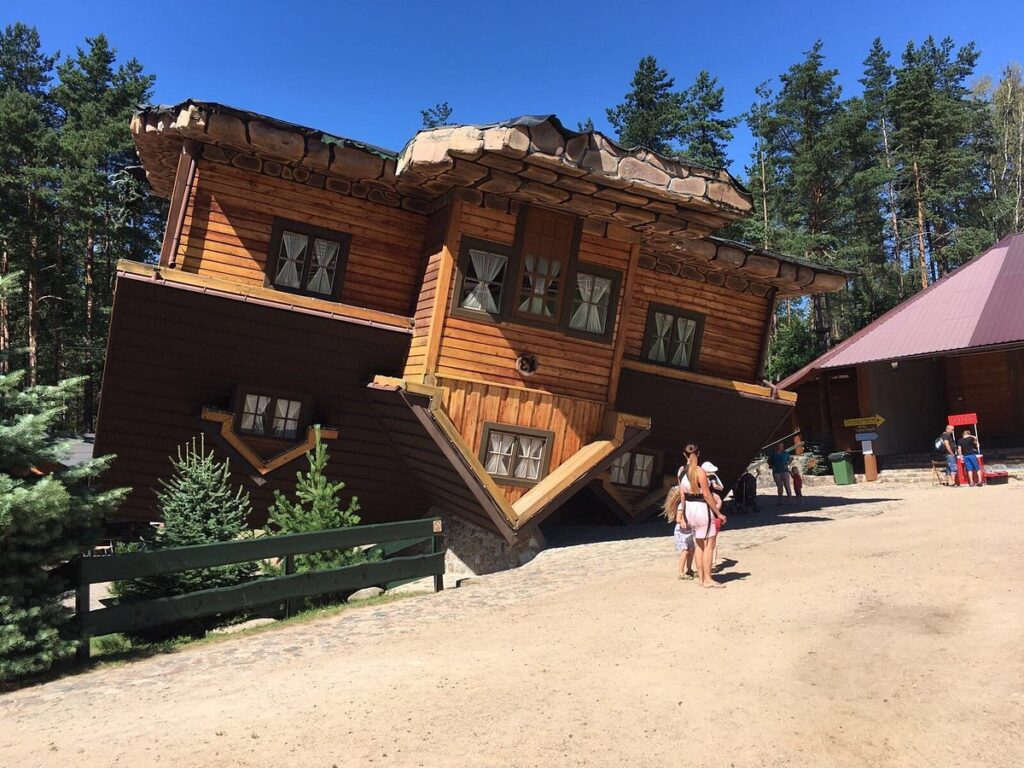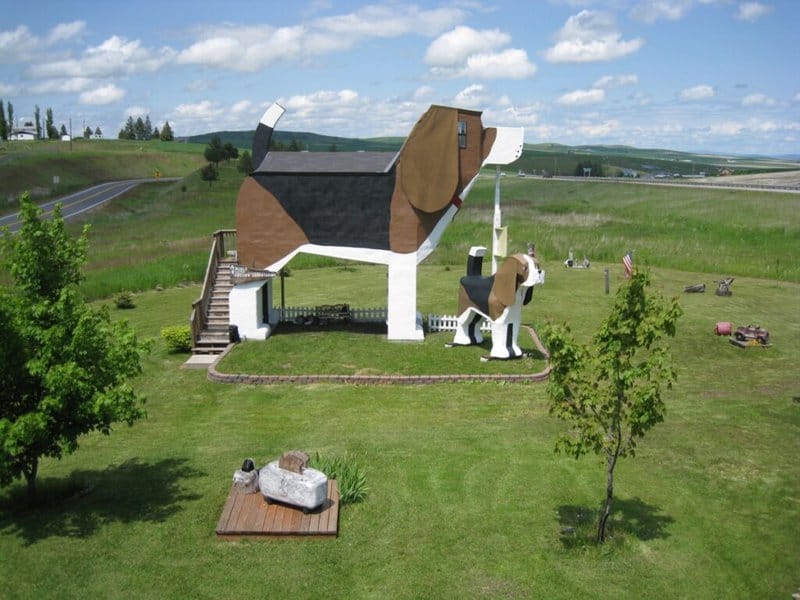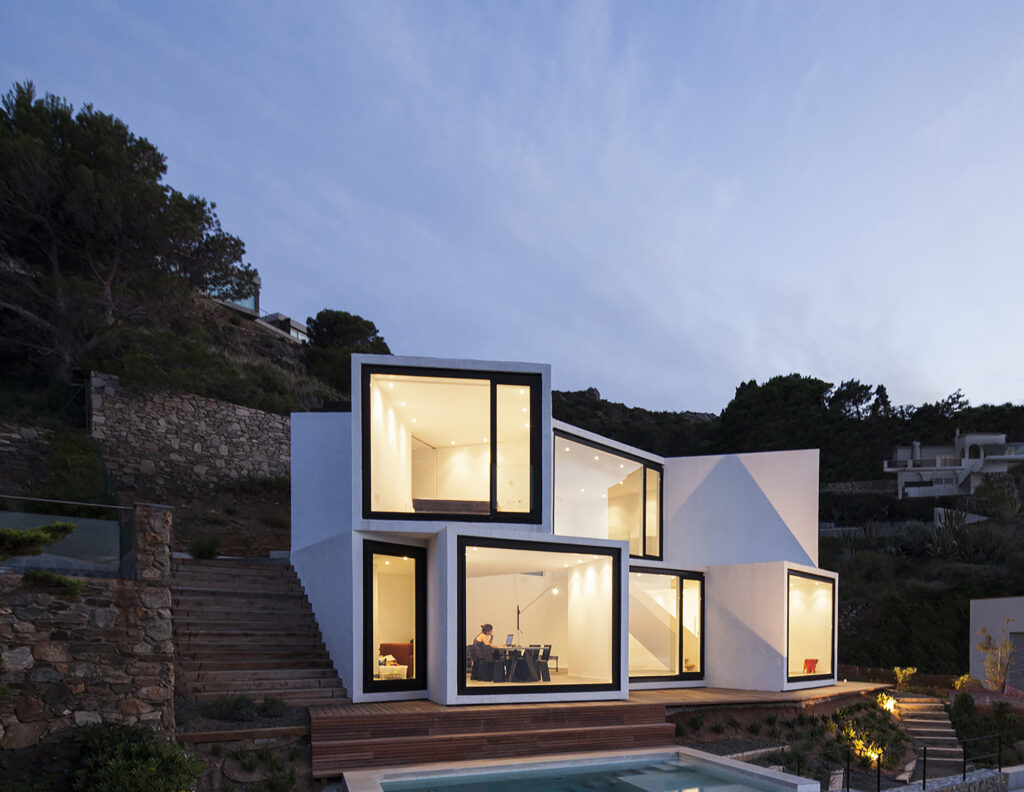Some houses are so striking that they turn into must-see destinations, drawing tourists from all over the world. Whether due to unconventional designs, artistic facades, or historical significance, these homes capture the imagination and redefine what a residence can be. From upside-down houses to futuristic masterpieces, these architectural wonders are more than just homes—they’re landmarks. Here’s a list of 25 homes that stand out for their extraordinary exteriors, making them popular tourist attractions.
The Upside Down House (Szymbark, Poland)

This gravity-defying home in Poland looks as though it was flipped upside down, complete with an inverted roof touching the ground. Designed as an artistic statement on the instability of modern society, the house confuses visitors with its surreal orientation. Inside, furniture and décor are also upside down, making walking through it a dizzying experience. Tourists flock to Szymbark to snap photos and challenge their sense of balance. The house sits at an angle, further exaggerating its topsy-turvy effect. Many guests leave feeling disoriented, as even gravity inside seems off. The structure has inspired similar designs in other countries. Despite its unusual construction, the house remains structurally sound.
The Snail House (Bulgaria)

Located in Sofia, this colorful house is shaped exactly like a giant snail. The smooth, curving design eliminates sharp angles, giving it a soft and organic feel. Painted in vibrant rainbow hues, the house stands out against the surrounding buildings. It is made from eco-friendly materials, with a self-regulating heating system. Tourists visit to admire its playful and imaginative architecture. The snail’s “eyes” are represented by two large windows on the upper level. This charming house is a favorite among visitors looking for quirky photo opportunities.
The Crooked House (Sopot, Poland)

This fairytale-like building, known as Krzywy Domek, appears to be melting or warping like something out of a dream. The design was inspired by the whimsical illustrations of Jan Marcin Szancer. The undulating walls and distorted windows create a playful, almost cartoonish appearance. It houses a shopping center and restaurants, attracting curious tourists year-round. The glass facade enhances its surreal look, reflecting the surroundings in a wavy manner. Despite its irregular shape, the structure is fully functional and stable. The Crooked House is one of the most photographed buildings in Poland. Visitors love how it defies traditional architectural norms.
The Stone House (Fafe, Portugal)

Resembling something from “The Flintstones,” this home is built between four massive boulders. It blends seamlessly with the natural landscape, making it hard to distinguish from a natural rock formation at first glance. The house was constructed in 1974 as a rural retreat, with simple furnishings inside. Over the years, it has become a major tourist attraction due to its unique structure. Visitors are fascinated by the way the house integrates into its rocky environment. The Stone House has no electricity but features a rustic fireplace. Its location in the mountains offers breathtaking panoramic views. Many tourists visit to admire its primitive yet charming aesthetic.
The Nautilus House (Mexico City, Mexico)

This seashell-shaped house was inspired by the smooth curves and patterns of marine life. Designed by architect Javier Senosiain, it embodies organic architecture, blending art and function. The exterior features a colorful mosaic that mimics a shell’s natural pattern. Inside, open spaces, flowing walls, and stained-glass windows create an underwater atmosphere. The house is also eco-friendly, using natural ventilation and sustainable materials. Visitors admire how the structure seems to flow naturally from one section to another. The lush interior gardens further enhance its connection to nature. The Nautilus House is a favorite among architecture enthusiasts and photographers.
The Dog Bark Park Inn (Idaho, USA)

This charming bed-and-breakfast is shaped like a giant beagle, standing 30 feet tall. Designed by artists Dennis and Frances Sullivan, it serves as both a lodging experience and a roadside attraction. The entrance is through the beagle’s belly, and the interior features dog-themed decor. Guests can sleep in the “head” while smaller spaces, like the muzzle, serve as reading nooks. The structure is made of wood and hand-painted to resemble a real dog. Tourists love taking quirky photos with the giant beagle before checking in. The inn is a must-visit for dog lovers and fans of unusual architecture.
The Cloud House (Australia)

This Melbourne home features a striking cloud-shaped extension at the back, giving it an artistic contrast to its traditional Victorian facade. The white, curved cloud-like structure houses a modern living space, while the front remains a classic brick home. The transition between the old and new elements is seamless, making it an architectural wonder. Inside, the design incorporates open spaces, high ceilings, and natural light. The house is popular among tourists fascinated by experimental architecture. The playful yet functional design has won several architectural awards. It symbolizes the blend of heritage and innovation in modern housing.
The Mushroom House

The Mushroom House in Cincinnati is a whimsical, organic-looking home that resembles a giant mushroom sprouting from the ground. Designed by architect Terry Brown, this one-of-a-kind structure features curving walls, irregular windows, and a roof that mimics the shape of a toadstool. Built between 1992 and 2006, the house incorporates a mix of wood, metal, and stained glass, creating a magical, almost fairytale-like appearance. Brown, who was also a professor at the University of Cincinnati, used the house as both his residence and a creative architectural experiment. Tourists and architecture enthusiasts visit to marvel at its artistic design and unconventional approach to construction. The home has become a well-known landmark in Cincinnati, drawing comparisons to fantasy settings like those in “Alice in Wonderland.” Despite its playful look, the Mushroom House is structurally sound and a true testament to organic architecture.
The Egg House (China)

This tiny, egg-shaped house in Beijing was designed as an affordable living solution for urban workers. Made from bamboo and eco-friendly materials, it is lightweight yet durable. The compact interior includes a bed, a small workspace, and storage compartments. Tourists visit to see how minimal space can be transformed into a functional home. Its innovative design highlights the potential for sustainable, small-scale housing. The Egg House has inspired similar micro-home projects around the world. It stands as a symbol of modern urban adaptability.
The Mirror House (Italy)

The Mirror House in Italy is a stunning architectural masterpiece designed to blend seamlessly with its environment. Its exterior is covered in reflective glass panels, which mirror the surrounding landscape, making the house almost invisible at certain angles. The design was created to minimize the building’s visual impact on nature while maximizing natural light inside. Tourists visit the site to witness the optical illusion firsthand, as the house appears to disappear into the scenery. The modern interior contrasts with the exterior, offering a sleek and minimalist living space. This house serves as a perfect example of architecture harmonizing with nature through innovative design.
The Flintstone House (California, USA)

Nestled in the hills of Hillsborough, California, the Flintstone House is a quirky, prehistoric-inspired home that looks like it came straight out of the beloved cartoon. Built in the 1970s using a unique construction technique called shotcrete, the house has a distinctive, rounded, cave-like structure. Its bulbous orange and purple exterior makes it instantly recognizable, drawing curious tourists and photographers. The home’s interior follows the same organic design, with flowing, irregularly shaped rooms and rock-like textures. Over the years, the house has faced both admiration and controversy, as local officials once debated whether its eccentric design fit the neighborhood. However, it remains a beloved landmark, often referred to as “The Yabba Dabba Doo House.” Today, it stands as a testament to creative architecture, attracting fans of both design and nostalgia alike.
The Shoe House (Pennsylvania, USA)

The Shoe House in Pennsylvania, USA, is a quirky home shaped like a giant boot. Built in 1948 by Mahlon Haines, a shoe salesman, it was originally a marketing tool to promote his footwear business. The house features multiple levels, with a living room in the toe, a kitchen in the heel, and bedrooms in the ankle. Over the years, it has been used as a guesthouse, museum, and even an ice cream shop. Visitors are drawn to its whimsical design and enjoy guided tours showcasing its history. Today, the Shoe House remains a beloved roadside attraction, celebrating both unique architecture and creative advertising.
The Airplane House (Nigeria)

Located in Abuja, Nigeria, the Airplane House was built by a man named Said Jammal as a tribute to his wife, who loves traveling. The house is shaped like a full-sized aircraft, complete with wings extending outward and a cockpit at the front. Its unique design makes it one of the most recognizable homes in Nigeria, attracting tourists and architecture enthusiasts alike. Inside, the home is fully functional, featuring multiple floors and living spaces designed within the airplane structure. The house symbolizes love, adventure, and creativity, blending aviation with residential architecture. Visitors are often amazed by the level of detail, making it a popular stop for those exploring unique buildings in Africa.
The Shell House (Isla Mujeres, Mexico)

The Shell House, or Casa Caracol, is a stunning vacation rental designed to resemble a giant seashell. Located on the tropical island of Isla Mujeres, it features smooth, curving white walls that mimic the natural form of a conch shell. The exterior is decorated with seashell-inspired details, while the interior continues the oceanic theme with spiral staircases and rounded rooms. Large windows offer breathtaking views of the Caribbean Sea, enhancing the home’s connection to its surroundings. Visitors love its whimsical design, making it one of the most photographed attractions on the island. The Shell House provides a unique stay, allowing guests to feel like they’re living inside a piece of the ocean.
The UFO House (Taiwan)

The UFO House, also known as the Sanzhi Pod Houses, was a collection of futuristic, pod-shaped structures built in the late 1970s. Designed as a seaside resort, the homes featured rounded, modular designs that resembled flying saucers. The development was abandoned before completion due to financial troubles and superstitions about the land being cursed. Over time, the eerie, decaying pods became a popular site for urban explorers and photographers. Despite their unique appearance, the structures were eventually demolished in 2010. Today, the UFO House remains a fascinating piece of architectural history, remembered for its otherworldly design and mysterious past.
The Hobbit House (Wales, UK)

Nestled in the countryside of Wales, this charming underground home looks like it belongs in Middle-earth. Inspired by J.R.R. Tolkien’s “The Lord of the Rings,” the house features a round door, grass-covered roof, and earthy interior. It was built using sustainable materials like reclaimed wood, stone, and natural plaster, making it an eco-friendly dwelling. The cozy, cave-like structure blends seamlessly with the landscape, providing insulation and energy efficiency. Visitors are drawn to its fairytale-like appearance and the sense of stepping into a fantasy world. This Hobbit-style home has become a must-see attraction for Tolkien fans and eco-conscious travelers alike.
The Basket Building (Ohio, USA)

The Basket Building in Newark, Ohio, is a massive, seven-story office building shaped like a giant woven picnic basket. It was originally the headquarters of the Longaberger Company, a manufacturer of handcrafted baskets. Designed to mimic the company’s signature product, the structure features intricate basket-like details, including two massive handles on top. The unique design made it a local landmark and a popular roadside attraction. Although the company closed, efforts have been made to preserve the building due to its architectural significance. Tourists visit to marvel at its whimsical appearance and take photos of this one-of-a-kind structure.
The Sunflower House (Spain)

The Sunflower House is an innovative, solar-powered home designed to maximize sunlight exposure throughout the day. Located on the Mediterranean coast, it features a rotating structure that follows the sun, much like a real sunflower. The house’s design allows for energy efficiency, reducing the need for artificial lighting and heating. Large glass panels and open spaces provide stunning ocean views while optimizing natural light. Built with sustainable materials, it blends modern architecture with eco-conscious living. Tourists visit to witness its dynamic movement and cutting-edge solar technology in action.
The Car House (Austria)

This eye-catching home in Austria is designed to resemble a luxury sports car, complete with sleek curves and metallic finishes. The exterior mimics the aerodynamic shape of a high-performance vehicle, making it look like a giant parked car. Large tinted windows and functional headlights add to the illusion, making it a favorite spot for car enthusiasts and tourists. The interior is just as stylish, featuring racing-themed decor and high-tech amenities. It was built by a passionate automobile lover who wanted to merge his two biggest interests: cars and architecture. Visitors often stop by to take photos, amazed at how a house can so closely resemble a real vehicle.
The Piano and Violin House (China)

This elegant structure in Huainan, China, is shaped like a giant piano with a transparent violin leaning against it. The violin serves as the entrance, with a staircase leading into the main building. Designed by architectural students, it symbolizes the city’s appreciation for music and the arts. The building is illuminated at night, creating a magical effect. Inside, it houses a music school and exhibition space. Tourists visit to admire its creative design and take photos in front of the massive instruments. Its glass violin contrasts beautifully with the sleek black piano. The house stands as one of the most artistic architectural landmarks in China.
The House on the Rock (Wisconsin, USA)

This unusual home is perched atop a rocky outcrop and features an eclectic mix of design styles. Built by Alex Jordan Jr., it started as a personal retreat but expanded into a massive attraction. The house includes bizarre collections, odd architectural elements, and even an indoor infinity room extending into the air. Its dark, winding corridors and low ceilings create a surreal experience. One of the most famous exhibits is a room with the world’s largest carousel. Visitors are captivated by the home’s eerie yet fascinating atmosphere. The House on the Rock has even inspired movies and books due to its mysterious charm.
The Wooden Skyscraper (Russia)

Located in Arkhangelsk, this towering wooden structure was built by a single man, Nikolai Sutyagin. Originally intended as a two-story home, Sutyagin kept adding floors until it reached 13 stories high. The house, constructed without formal architectural plans, became an iconic landmark. Unfortunately, due to safety concerns, most of the structure was dismantled. However, remnants of the original tower still attract tourists intrigued by its unique history. The Wooden Skyscraper remains a symbol of unconventional DIY architecture. Its ambitious design continues to inspire stories and legends.
The House of Shells (Spain)

The Casa de las Conchas in Salamanca is a 15th-century building adorned with over 300 shell motifs. The shells, symbolizing the Order of Santiago, were carved into the facade as a tribute to a knight. The structure blends Gothic, Moorish, and Renaissance elements, making it a historical masterpiece. Visitors are drawn to its intricate design and the legends surrounding its construction. The house is now a public library, allowing tourists to explore its rich interior. Its exterior is especially striking at sunset when the shells cast dramatic shadows. The House of Shells is one of Spain’s most unique historic homes.
The Glass House (Connecticut, USA)

Designed by architect Philip Johnson, this transparent house is an icon of modernist architecture. Built in 1949, it features floor-to-ceiling glass walls, eliminating the barrier between indoors and outdoors. The minimalist structure allows nature to be part of the living experience. Tourists visit to appreciate its revolutionary design and scenic setting. The house is now part of a museum, showcasing mid-century architectural innovation. Despite its openness, the house maintains a sense of privacy through strategic positioning. It remains a masterpiece of simplicity and harmony with nature.
The Bubble Palace (Théoule-sur-Mer, France)

This futuristic mansion, known as Palais Bulles, looks like a cluster of giant bubbles. Designed by Hungarian architect Antti Lovag, it embraces free-form architecture with curving walls and rounded windows. The home was once owned by fashion designer Pierre Cardin, adding to its fame. Its organic shapes create an otherworldly aesthetic, making it a popular tourist spot. The house overlooks the Mediterranean Sea, providing stunning views. Inside, every room follows the same rounded, flowing design. The estate includes terraces, pools, and gardens that blend seamlessly with the structure. Many tourists visit to experience its sci-fi-like atmosphere.

